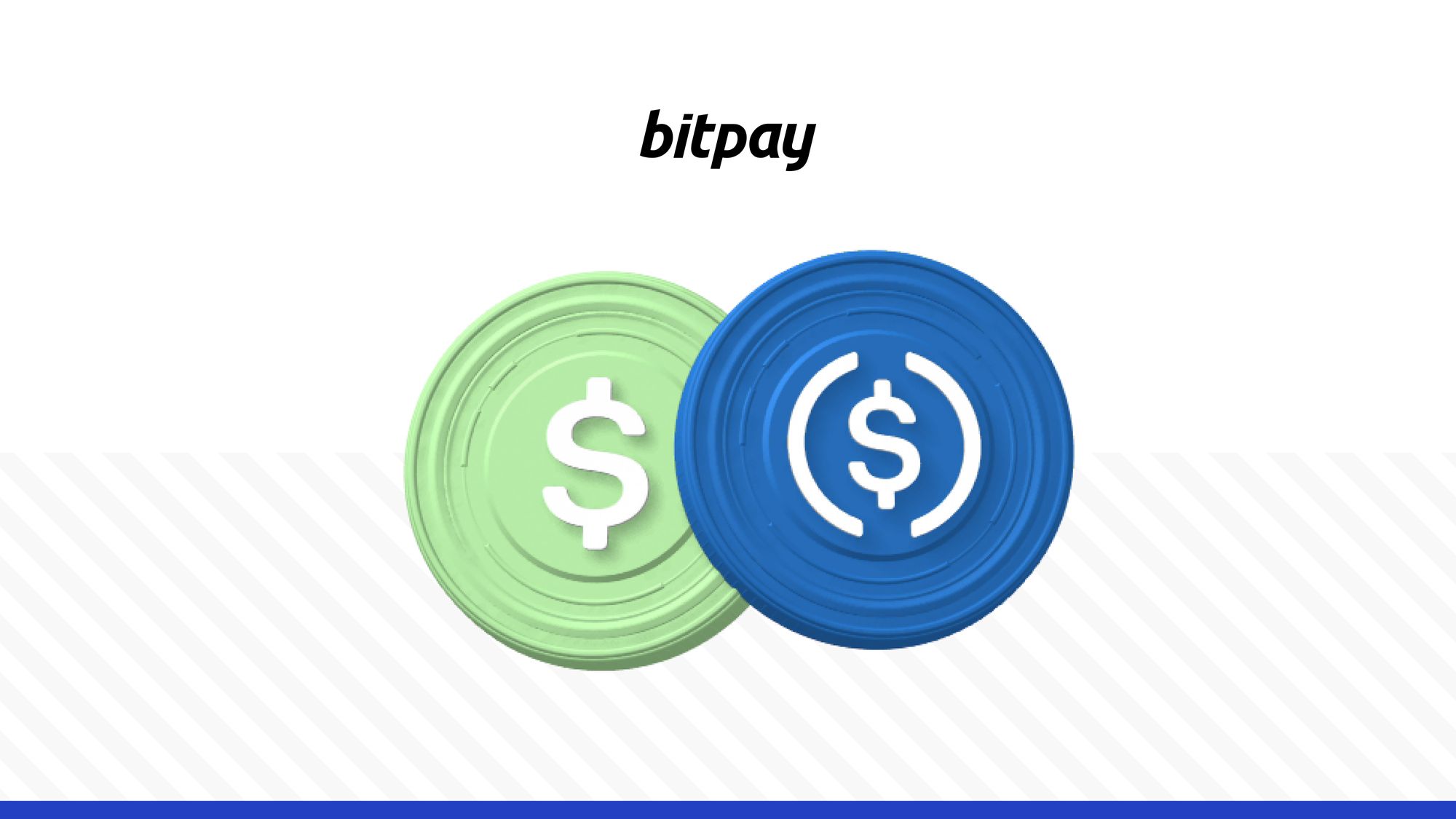Stablecoins are a type of cryptocurrency whose value is “pegged” to another currency, most often the U.S. dollar. They maintain this peg through reserves of dollars, other cryptos or a mix of both kept in U.S.-controlled bank accounts. Stablecoins are frequently used as a hedge against crypto market volatility, or for generating passive income through staking or lending. Some popular stablecoins include Tether (USDT), USD Coin (USDC), Euro Coin (EUROC) and Binance Dollar (BUSD). They can be purchased or swapped in the BitPay app in addition to your favorite crypto exchanges.
Learn all about stablecoins, including their origins, how they work, how to use them and popular stablecoins you can start using today.
A hallmark of most cryptocurrencies is price volatility, which can limit the appeal to a large swath of the investing public. These dramatic, often unpredictable price swings also stand as an obstacle to mainstream adoption of crypto as a medium of exchange for everyday purchases. Users and merchants are both less likely to want to transact business using crypto if the price of an item can end up radically changing after only a day or two.
Enter stablecoins, whose values are linked or “pegged” to another, more stable asset like U.S. dollars or gold. Stablecoins are designed to maintain that price peg no matter what’s going on in the crypto market or broader economy, using a variety of methods. This makes stablecoins a favored safe haven among crypto users to shield their holdings from market volatility.
Today there are approximately 200 globally distributed stablecoins. Some of the most popular are issued directly by exchanges themselves like USD Coin (USDC), Pax Dollar (USDP), Binance Dollar (BUSD) and Gemini Dollar (GUSD).
In this article
- What is a stablecoin?
- What are stablecoins used for?
- What are the most popular stablecoins?
- How to use stablecoins
- How to buy stablecoins
What are stablecoins?
Stablecoins are a type of cryptocurrency designed to offer the flexibility of digital assets with the price stability of fiat currency. Their value is fixed, usually on a 1:1 basis with the U.S. dollar. This means that a single unit of a stablecoin is worth exactly one dollar at all times. Anytime the price peg is threatened, the issuing organization must take action to bring it back to that $1.00 value. There are multiple ways that coins can maintain their value.
What are the different types of stablecoins?
The biggest difference in stablecoins will be how they backed, including the assets used to back the coins and the organization behind the coin.
Fiat or commodity-backed stablecoins
The first, most popular method is by backing up every stablecoin in supply with an equivalent value in fiat currency or cash equivalents. This is known as a fiat-backed stablecoin. This means for every one of the stablecoins in circulation, an equivalent of 1 USD is held on reserve in U.S. bank accounts owned by the issuer. These reserves are routinely audited by independent accounting firms, usually monthly, with details on its holdings prominently published for public viewing.
Cryptocurrency-backed stablecoins
Another similar method of maintaining a stablecoin’s price peg is through crypto-collateralization, in which stablecoins are backed by reserves of other cryptocurrencies. However, since cryptocurrencies are so volatile compared to fiat currency, crypto-backed stablecoins are usually overcollateralized to help maintain their peg during times of market volatility. For instance, the Dai (DAI) stablecoin issued by MakerDAO is collateralized at 150%, meaning every 1 DAI in circulation is backed by 1.5x its equivalent value in Ethereum (ETH) or other cryptocurrencies.
Algorithm-backed stablecoins
The third and final method of maintaining a stablecoin’s peg is through use of an algorithm, or smart contracts which automatically execute to manipulate the circulating supply depending on market conditions. In times when an algorithmically-backed cryptocurrency is dropping in price, the smart contract decreases the circulating supply to increase its scarcity, and therefore its value. When a price creeps above the peg, the smart contract increases the circulating supply to keep the price stable.
In the case of fiat-backed stablecoins, a holder is able to exchange their stablecoins for an equivalent amount of dollars at any time, and vice versa. Some stablecoins are backed by other commodities like precious metals, oil and even real estate, though 1:1 redemption of your tokens for these assets isn’t quite as straightforward, if allowed at all.
What are stablecoins used for? What’s the purpose of stablecoins?
Stablecoins serve sort of like a bridge between volatile crypto-assets and highly stable real-world assets. They offer users a greater degree of price stability than other cryptocurrencies. The price fluctuations of cryptocurrencies such as Bitcoin or Dogecoin, for example, can make it difficult for merchants to accurately price their items. If there’s a chance the $5 in crypto a customer paid for a cup of coffee today will only be worth $4 tomorrow, that’s a bad deal for the merchant.
It can also swing the other way where the consumer gets the short end of the bargain. We all remember the infamous story of the person who bought 2 large pizzas in 2010 for 10,000 Bitcoin (valued at $690M at the all-time-high price in November 2021).
Crypto traders leverage stablecoins to reduce fees when selling or purchasing other cryptocurrencies, since many exchanges don’t impose a fee for conversion to or from stablecoins. Instead of transacting in U.S. dollars each time and paying the accompanying fees when cashing out, a crypto user can buy an amount of a stablecoin to keep within the exchange’s walls. This allows a user to attempt to time crypto purchases with a market upswing, or ride out a downswing, without losing spending power in the meantime.
Stablecoins are particularly popular during periods of market volatility, when holders seeking to protect their assets in a down market convert their less-stable cryptocurrencies to something more predictable.
What are the most popular stablecoins? How many stablecoins are there?
There are approximately 200 stablecoins today. Some of the most popular examples include:
Tether (USDT) is considered the world’s first stablecoin and has the highest market cap of all its peers, sitting at just under $72.5 billion as of June 2022. The breaking of its peg in May of 2022 is considered a watershed moment in the history of stablecoins.
USD Coin (USDC) is a stablecoin representing tokenized U.S. dollars on the Ethereum (ETH) blockchain. It’s managed through a consortium called Centre formed by Circle and Coinbase. Circle is a peer-to-peer payments company with backers including Goldman Sachs, and Coinbase is one of the most well-known cryptocurrency exchanges.
Binance Dollar (BUSD) is a stablecoin backed by the U.S. dollar issued on the Ethereum (ETH) blockchain. It was created through a partnership between Binance, the world’s largest cryptocurrency exchange, and Paxos, a leading crypto infrastructure provider. It’s one of the first government-regulated stablecoins to be approved by the New York State Department of Financial Services (NYDFS).
Dai (DAI) is a cryptocurrency on the Ethereum (ETH) blockchain regulated and maintained by MakerDAO, a decentralized autonomous organization, or DAO. Dai is considered one of the earliest examples of decentralized finance (DeFi) to garner mainstream adoption
Pax Dollar (USDP) was formerly known as Paxos Standard (PAX). It’s a stablecoin on the Ethereum (ETH) blockchain with a value pegged to the U.S. dollar. It’s the native cryptocurrency of Paxos, a financial institution regulated by the NYDFS.
Gemini Dollar (GUSD) an ERC-20 stablecoin built on the Ethereum (ETH) blockchain. Its value is pegged 1:1 to the U.S. dollar, and backed by reserves held in FDIC-insured bank accounts. It was created by cryptocurrency exchange Gemini, which touts it as the first regulated stablecoin. Along with USDP and BUSD, GUSD is one of three government-regulated stablecoins in existence.
PayPal USD (PYUSD) is a newly released stablecoin by payments processor, PayPal, in collaboration with Paxos. Paxos Trust Company launched PayPal USD (PYUSD), a stablecoin backed by dollars and other assets, with a 1-1 value ratio to the US dollar. Ensuring transparency, Paxos will release monthly asset reports and undergo third-party audits, with the first proof-of-reserves statement expected in September 2023.
How to use stablecoins
Stablecoins’ primary use cases mirror most cryptocurrencies: a store of value and a low-cost medium of cross-border exchange. But their stable value opens up some utility possibilities most other cryptocurrencies can’t offer like easier means of distributing funds across borders, plus lending and borrowing.
Because their value is usually tied to real assets, stablecoins are commonly used for passive-income generating activities like crypto lending and staking. By locking up stablecoins within a specific network or protocol, holders can earn interest rates significantly higher than traditional bank interest, ranging from 5-15% annually. However these rates are subject to fluctuations, and staked assets are not covered by FDIC insurance.
As a crypto customer, you can spend stablecoins at merchants around the world directly from your wallet. Seamlessly spend your Gemini USD (GUSD), USD Coin (USDC), Binance USD (BUSD), Dai (DAI), PayPal USD (PYUSD), Tether USD (TUSD), and more as easily online or in-person.
Related: Read our full guide to using and spending stablecoins.
The best crypto app to buy, store, swap and spend stablecoins
How to buy stablecoins
Because so many are directly issued by exchanges themselves, stablecoins are widely available for purchase. To start buying stablecoins, first choose a trustworthy exchange, then create an account, select the wallet of your choice and the amount you wish to purchase.
You can also buy stablecoins securely and easily with BitPay. Download the app then tap “Buy Crypto” and choose the amount of the stablecoin you want to purchase. Confirm your payment method, for which BitPay offers flexible options including debit card, credit card, bank account, or Apple Pay and Google Pay.
All that’s left to do then is review personalized rate offers prepared just for you through BitPay’s trusted partners. When you buy stablecoins with BitPay you can be certain you’ll always get the best possible prices without hidden fees or markups.
Stablecoins for business
BitPay gives merchants the ability to accept stablecoins. This means consumers across the world can use and spend stablecoins straight from their wallet. Additioanlly, BitPay Send allows organizations to send and distribute stablecoin payments across borders. This is ideal for paying affiliates, vendors, making payroll payments, and much more.


